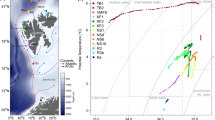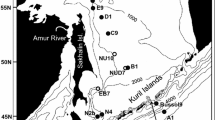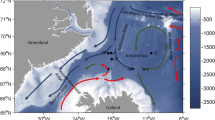Summary
Pelagic copepod populations under the pack ice of the Antarctic Weddell Sea were sampled with a 50 μm net between October 2 and December 7, 1986, to study their abundance and developmental stage composition before and at the onset of the vernal phytoplankton bloom. Subadult stages and adult females were incubated to estimate rates of development and egg production. Copepod densities in the upper 200 m were highest for the small-sized species Oithona similis, Oncaea curvata and Ctenocalanus citer. About 95% of the copedite stages belonged to these species, dominated by Oithona. The copepodids were outnumbered by the nauplii in all species, except in Oncaea. The stage distribution in the small-sized species was bimodal with peaks in N3 and C4. The larger species Calanus propinquus and Metridia gerlachei showed peaks in nauplii only. Eggs were relatively abundant in all small and large species. Animals smaller than 1 mm not only were more abundant than the larger ones, but also had a higher total potential respiration. Eggs were produced by incubated females in sea water virtually without food at 0°C. Eggs hatched, and Oithona nauplii developed at a rate of about 7 days per stage. Copepodite stages did not develop significantly. Reproduction in the most abundant species commonly occurred before the algal spring increase when food levels were very low. Maintenance of a stable stage distribution at the expense of a high juvenile mortality seemed to be characteristic for the overwintering strategy of Antarctic copepods.
Similar content being viewed by others
References
Bergeron J-PR, Alayse-Danet A-M, Razouls C (1985) Metabolic adaptations of Antarctic mesozooplankton systems to the phytoplankton standing crop in late austral summer. In: Gray JS, Christiansen ME (eds) Marine biology of polar regions and effects of stress on marine organisms. Wiley and Sons, Chichester, pp 157–167
Checkley DM Jr (1980) The egg production of a marine planctonic copepod in relation to its food supply: laboratory studies. Limnol Oceanogr 25:430–446
Chojnacki J, Weglenska T (1984) Periodicity of composition, abundance, and vertical distribution of summer zooplankton (1977/1978) in Ezcurra Inlet, Admiralty Bay (King George Island, South Shetland). J Plankton Res 6:997–1019
Conover RJ (1967) Reproductive cycle, early development, and fecundity in laboratory populations of the copepod Calanus hyperboreus. Crustaceana 13:61–72
Daan R (1987) Impact of egg predation by Noctiluca miliaris on the summer development of copepod populations in the southern North Sea. Mar Ecol Prog Ser 37:9–17
Daan R, Gonzalez SR, Klein Breteler WCM (1988) Cannibalism in omnivorous calanoid copepods. Mar Ecol Prog Ser 47:45–54
Davis CC (1976) Overwintering strategies of common planktic copepods in some north Norway fjords and sounds. Astarte 9:37–42
Eicken H, Elbrächter M, Fahrbach E, Gordon L, Klöser H, Marschall H-P, Moore S, Rabsch U, Rohardt G, Rhein M, Scharek R, Schiel S, Smetacek V, Veth C, Weiss R, Weppernich R, Zaucker F (1987) The under-ice water layer. In: Schnack-Schiel SB (ed) The winter expedition of RV “Polarstern” to the Antarctic (ANT V/1-3). Rep Polar Res 39:182–190
Elbrächter M, Gieskes WWC, Rabsch U, Scharek R, Schaumann K, Smetacck V, Veth C (1987) Phytoplankton and heterotrophic microorganisms in the water column. In: Schnack-Schiel SB (ed) The winter expedition of RV “Polarstern” to the Antarctic (ANT V/1-3). Rep Polar Res 39:190–196
Faber DJ (1966) Free-swimming copepod nauplii of Narragansett Bay with a key to their identification. J Fish Res Board Can 23:189–205
Falk-Petersen I-B (1982) Ecological investigations on the zooplankton community of Balsfjorden, northern Norway. Planktonic eggs and larvae from March 1978 to February 1980. Sarsia 67:69–78
Foster AB (1987) Composition and abundance of zooplankton under the spring sea-ice of McMurdo Sound, Antarctica. Polar Biol 8:41–48
Fransz HG, Hagen W, Hempel I, Marschall H-P, Marschall S, Mizdalski E, Schiel S (1987) Zooplankton. In: Schnack-Schiel SB (ed) The winter expedition of RV “Polarstern” to the Antarctic (ANT V/1-3). Rep Polar Res 39:197–205
Fulton J (1973) Some aspects of the life history of Calanus plumchrus in the Strait of Georgia. J Fish Res Board Can 30:811–815
Gibbons SG, Ogilvie HS (1932) The development stages of Oithona helgolandica and Oithona spinirostris, with a note on the occurrence of body spines in cyclopoid nauplii. J Mar Biol Assoc UK 18:529–551
Gieskes WWC, Veth C, Wöhrman A, Gräfe M (1987) Secchi disc visibility world record shattered. EOS 68:123
Grønvik S, Hopkins CCE (1984) Ecological investigations of the zooplankton community of Balsfjorden, northern Norway: generation cycle, scasonal vertical distribution, and seasonal variations in body weight and carbon and nitrogen content of the copepod Metridia longa (Lubbock). J Exp Mar Biol Ecol 80:93–107
Hagen W (1988) Zur Bedeutung der Lipide im Antarktischen Zooplankton. Ph D thesis, pp 1–169
Hart T (1942) Phytoplankton periodicity in Antarctic surface waters. Discovery Rep 21:261–356
Heinrich AK (1962) The life histories of plankton animals and seasonal cycles of plankton communities in the oceans. J Cons Perm Int Explor Mer 27:15–24
Hempel G (1987) Summary and itinerary. In: Schnack-Schiel SB (ed) The winter expedition of RV “Polarstern” to the Antarctic (ANT V/1-3). Rep Polar Res 39:135–140
Heron GA, Bowman TE (1971) Postnaupliar developmental stages of the copepod crustaceans Clausocalanus laticeps, C. brevipes, and Ctenocalanus citer (Calanoida: Pseudocalanidea). In: Llano GA, Wallen IE (eds) Biology of the Antarctic Seas IV, vol 17. Antarct Res Ser, pp 141–165
Hirche H-J, Bohrer RH (1987) Reproduction of the Arctic copepod Calanus glacialis in Fram Strait. Mar Biol 94:11–17
Hopkins CCE, Tande KS, Grønvik S (1984) Ecological investigations of the zooplankton community of Balsfjorden, northern Norway: an analysis of growth and overwintering tactics in relation to niche and environment in Metridia longa (Lubbock), Calanus finmarchicus (Gunnerus), Thysanoessa inermis (Kroyer) and T. raschi (M. Sars). J Exp Mar Biol Ecol 82:77–99
Hopkins TL (1985) The zooplankton community of Croker Passage, Antarctic Peninsula. Polar Biol 4:161–170
Ikeda T (1970) Relationship between respiration rate and body size in marine plankton animals as a function of the temperature of habitat. Bull Fac Fish Hokkaido Univ 21:91–112
Kaczmaruk BZ (1983) Occurrence and distribution of the Antarctic copepods along the ice shelves in the Weddell Sea in summer 1979/80. Meeresforschung 30:25–41
Klein Breteler WCM (1982) The life stages of four pelagic copepods (Copepoda: calanoida), illustrated by a series of photographs. Neth Inst Sea Res Publ Ser 6-1982:32 pp
Klein Breteler WCM, Fransz HG, Gonzalez SR (1982) Growth and development of four calanoid copepod species under experimental and natural conditions. Neth J Sea Res 16:195–207
Koeller PA, Barwell-Clarke JE, Whitney F, Takahashi M (1979) Winter condition of marine plankton populations in Saanich Inlet, BC Canada III. Mesozooplankton. J Exp Mar Biol Ecol 37:161–174
Krause M, Trahms J (1983) Zooplankton dynamics during FLEX '76. In: Sündermann J, Lenz W (eds) North Sea Dynamics, Springer, Berlin, pp 632–661
Landry MR (1983) The development of marine calanoid copepods with comment on the isochronal rule. Limnol Oceanogr 28:614–624
Marshall SM, Orr AP (1952) On the biology of Calanus finmarchicus. VII Factors affecting egg production. J Mar Biol Assoc UK 30:527–549
Murphy HE (1923) The life cycle of Oithona nana, reared experimentally. Univ Calif Publ Zool 22:449–454
Nassogne A (1972) Etudes préliminaires sur le rôle du zooplancton dans la constitution et le transfert de la matière organique au sein de la chaîne alimentaire marine en mer Ligure. Ph D thesis, Amsterdam, pp 1–237
Nishida S (1985) Taxonomy and distribution of the family Oithonidea (Copepoda, cyclopoida) in the Pacific and Indian Oceans. Bull Ocean Res Inst Univ Tokyo 20:1–167
Oberg M (1906) Die Metamorphose der Plankton-Copepoden der Kieler Bucht. Wiss Meeresunters 9:37–103
Ogilvie HE (1953) Copepod nauplii (1). Fich Ident Zooplanct 50:1–4
Schnack SB, Smetacek V, Bodungen B von, Stegmann P (1985a) Utilisation of phytoplankton by copepods in Antarctic waters during spring. In: Gray JS, Christiansen ME (eds) Marine biology of polar regions and effects of stress on marine organisms. Wiley and Sons, Chichester, pp 65–83
Schnack SB, Marschall S, Mizdalski E (1985b) On the distribution of copepods and larvae of Euphausia superba in Antarctic waters during February 1982. Meeresforschung 30:251–263
Tanaka O (1960) Biological results of the Japanese Antarctic research expedition. 10. Pelagic copepoda. Seto Mar Biol Lab Spec Publ Ser 1,10:1–177
Tande KS, Hopkins CCE (1981) Ecological investigations of the zooplankton community of Balsfjorden, northern Norway: the genital system in Calanus finmarchicus and the role of gonad development in overwintering strategy. Mar Biol 63:159–164
Vervoort W (1950) Plankton copepods from the Atlantic sector of the Antarctic. Verh Akad Wet Amsterdam 2,47:1–156
Bröckel K von (1985) Primary production data from the south-eastern Weddell Sea. Polar Biol 4:75–81
Vladimirskaya Ye V (1978) Age composition of winter populations of abundant copepod species in the southern part of the Scotia Sea. Oceanology 18:202–204
Voronina NM (1972) The spatial structure of interzonal copepod populations in the Southern Ocean. Mar Biol 15:336–343
Author information
Authors and Affiliations
Rights and permissions
About this article
Cite this article
Fransz, H.G. Vernal abundance, structure and development of epipelagic copepod populations of the eastern Weddell Sea (Antarctica). Polar Biol 9, 107–114 (1988). https://doi.org/10.1007/BF00442037
Received:
Accepted:
Issue Date:
DOI: https://doi.org/10.1007/BF00442037




